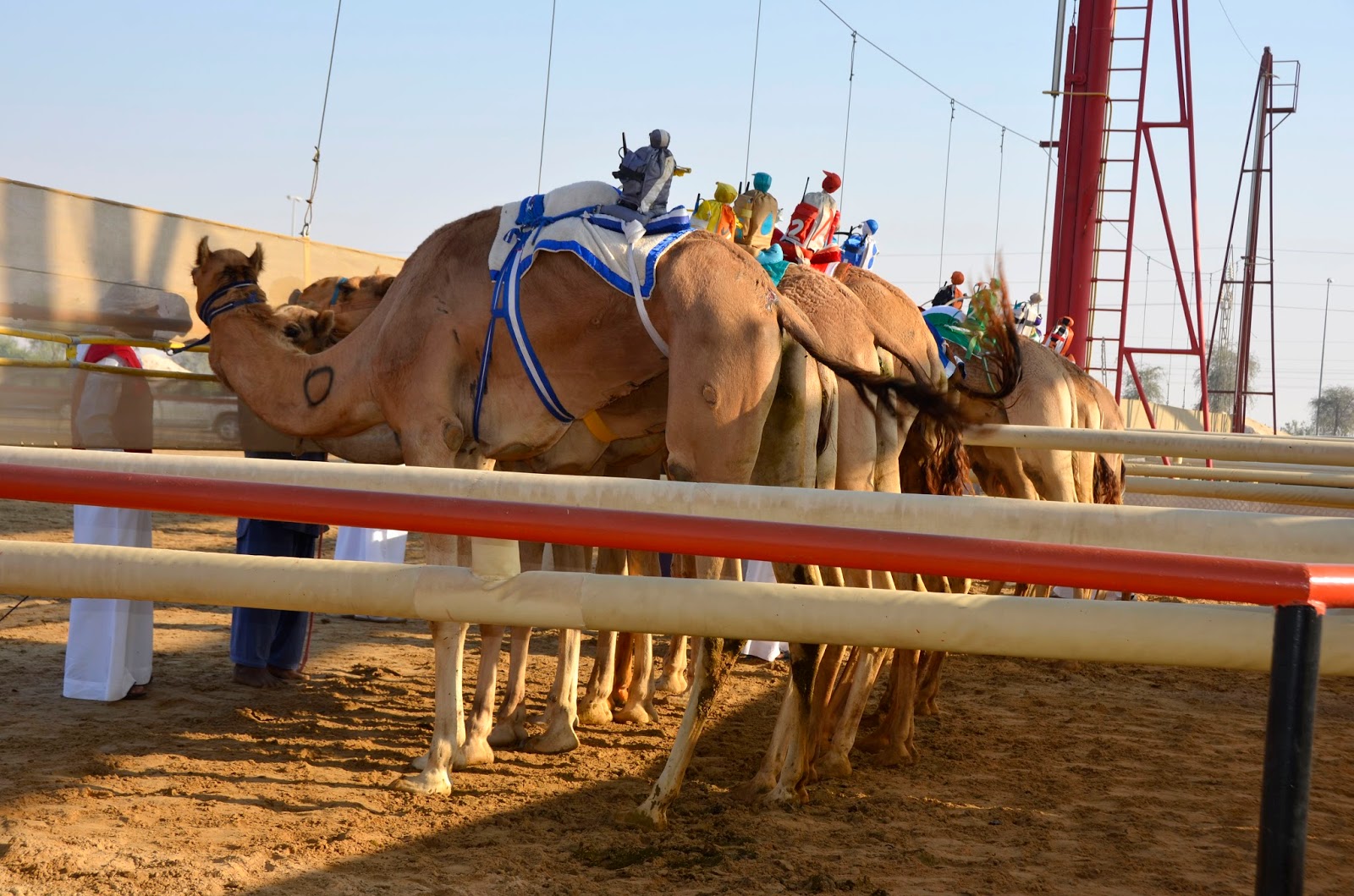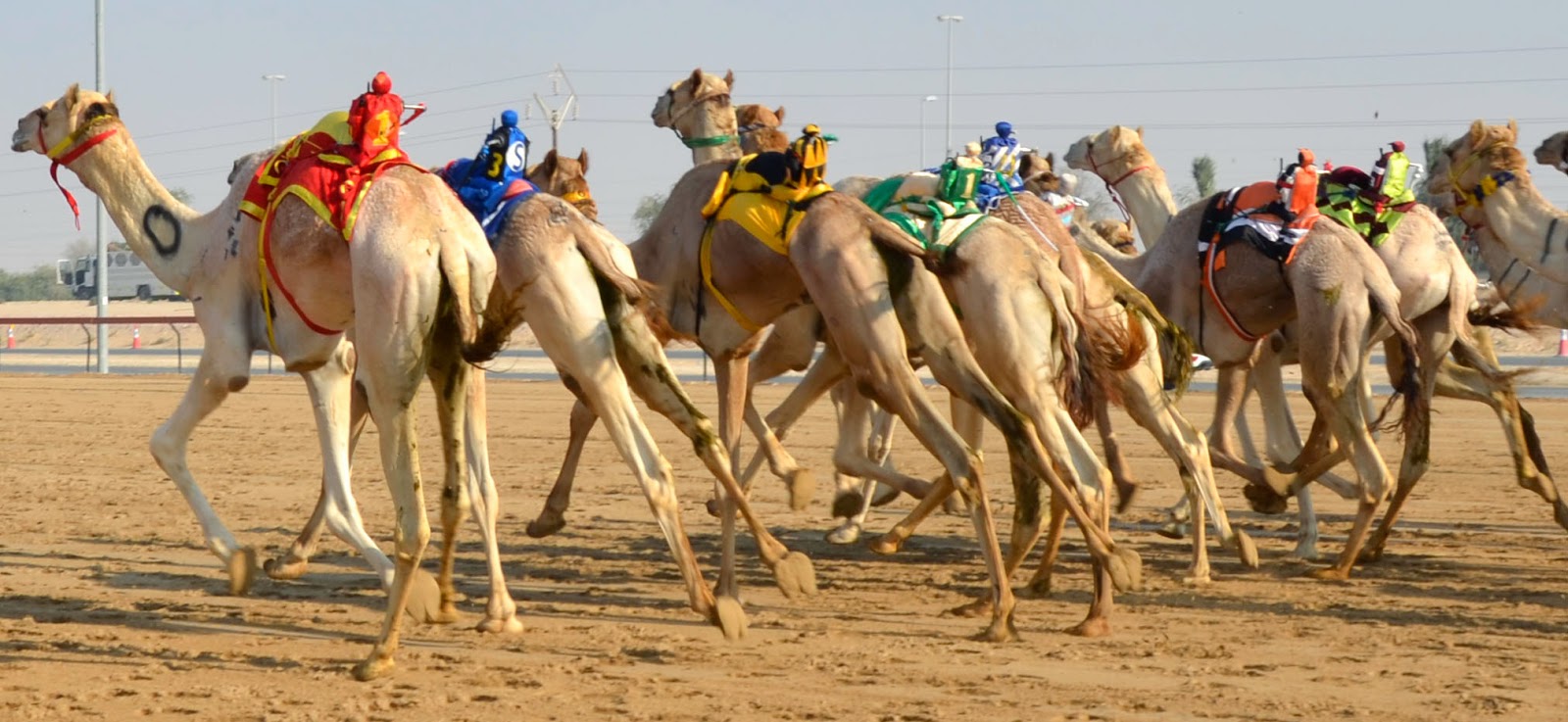January 7, 2015
Blog #1~ Modern Camel Racing in Dubai
We left for Dubai on January 5th, taking the newest
Emirate Airline airplane A380-800 from Los Angelos. Business class on this plane is like first
class on BA ~ with amazing service, food, movies and comfortable beds. Our 16
hour flight to Dubai seemed to go by quickly although we still didn’t manage
more than a few hours of sleep. Our trip destination was actually Sri Lanka but
John wanted to spend a day in Dubai first.
We had visited Dubai 2 years ago on our way to Oman and I thought he
wanted to return here because he was smitten with the Burj Khalifa, the world’s tallest tower (half a mile high). I knew he
wasn’t returning to see the world’s largest mall. Funny how men are attracted
by tall and very big things. I was less
interested in the Burj although I did have fond memories of the Palace Hotel
and watching the spectacular waterfall fountain ballet music
It quickly became apparent that John’s mission was to see
the camel races which were running for 3 days only when we were there. Surprisingly we found it difficult to find out from the internet and concierge where the races were held or what time they were to start. Even the taxi driver was not familiar with
these races and believed we wanted to see horse races at a different race track. With John’s I-pad in hand and the Pakistani
taxi driver willing to use his I-phone to call friends for directions we drove
for 45 minutes out into the desert searching for the race track. John turns to me delighted saying, “another
adventure”. Suddenly I see herds of
camels being led camel riders down a dirt track. We stop by a motor cade of 6-8 SUV vehicles
and our driver gets out asking in Arabic where the entrance is to the race. We
discover we have arrived. We find that
the men in these SUVs are the camel trainers who zoom along the road next to
the race track coaching their sprinting camels. Using a walkie-talkie they talk to their camels making
a throaty, clucking sound. Placed on the back of each racing camel is a tiny robot jockey (with rechargeable batteries and fancy silk clothes) weighing only a few
pounds that both transmit the trainer’s voice and sends a signal for the robot to whip the camel’s back.
Camel Racing a
Cultural Tradition
To our delight we have luckily happened upon a truly
authentic sport that is not a tourist attraction but a local tradition that has
been part of Arabian culture for generations.
Apparently some historians date camel racing back to the 7th
century. There were only a handful of tourists and no other taxis. We ask our driver to wait for us and he
smiles saying we will need him to get back.
He seems as excited by the event as we are.
Surprisingly the grandstand is mostly empty.
We are told that this lack of attendance does not mean a lack of passion
because most sheiks and fans prefer to watch the events live on a TV channel dedicated to camel racing. We
notice many cameras and an SUV with a camera on its roof which races along side the
trainer’s SUVs filming the race. Owning
a camel in the Gulf countries is considered an honor and even may be used to
pay a woman’s dowry. Like horses there
are thoroughbred camels with prices ranging from $2700 to $815,000. Camels cost about $275 a month to feed, train
and house them. First place in a
camel race can bring in over $200,000.
Betting is not allowed. I wonder what the objects are on the backs of the camels.
Camel Handlers
As I take pictures I realize I am one of only there women at this track. The camel handlers look at me with confusion as if I am from outer space. I feel like I am a strange zoo animal. However, I find these men quite handsome and stare back at them. Only the camels smile and wink at me.
Children are Replaced
with Robots
Racing camels in U.A.E. became more organized in the 80’s
and 90’s. Many camel owners originally used
light weight children as jockeys, some as young as 2 or 3 years of age. According
to a recent New York Times article these children were imported from countries such as
Afghanistan, Pakistan, and Sudan. Falls and injuries were common. Trading,
bartering and kidnapping of child jockeys as well as abuse were frightenly
frequent. It was estimated that 40,000
child jockeys were being used in the Persian Gulf. The horrors of human trafficking has damaged this
sport’s reputation, even though the practice of using children has been
officially banned for 12 years in the U.A.E.
The production of robots to replace children began in 2003. These robots
can be dressed with silk accessories to look like tiny jockeys which weigh only
a few pounds and sit on metal saddles. Trainers use remote entry clickers (like
you use for opening your car) to activate a spinning whip from their SUV and
the walkie talkies allow the trainer to speak to the camel.
The Race
 Three groupings of 5-6 camels are lined up behind the starting
line with their noses pressed against a dangling barriers waiting for the
signal and the gate to be lifted.
Three groupings of 5-6 camels are lined up behind the starting
line with their noses pressed against a dangling barriers waiting for the
signal and the gate to be lifted.  Each grouping of camels has Arabic men
checking their robots, whip and walkie talkies. The races are continuous as one
group of camels crosses the finish line, the gate is lifted and another race
starts.
Each grouping of camels has Arabic men
checking their robots, whip and walkie talkies. The races are continuous as one
group of camels crosses the finish line, the gate is lifted and another race
starts.
SUVs race around after the camels honking horns and coaching their
action through walkie-talkies and jockeys.
It is amazing to see these camels with such spindly legs gallop up to 40 miles an hour down this 3 mile track. I am remined of my days of rowing races in an 8-person shell
where a light-weight coxswain commuicates through a cox box and speakers to
coordinate the power of the rowers.
Finish Line
While I have been taking pictures John has been talking to a
Syrian camera man from Damascus about Syria.
He is told that the US is supporting ISIS and is the reason for Syrian’s
wars. This articulate, friendly and seemingly well educted man is a supporter of Bashar
el-Assad and holds Obama and the US government responsible for the woes of current Syria. I think about
technology advancing camel races and the technology of war with the use of
drones. I wonder how culture, social media and
modern technology informs our perceptions and belief systems and how we
discover truth. For our first day of travel my thoughts have been challenged. Am I just a camel being manipulated?

































This is the best post ever, will like to read more from you.
ReplyDeleteBuy Poison 15ml Online
Buy Kynoselen 100ml Online
Buy Glucodexa 30ml Online
Order Fluvet 50ml Online
Buy Diurizone 50ml Online
Buy Dexarace 20ml Online
Buy Dexapheylarthrite Online
Dexacortyl 100ml Horse Camel Supplements
Buy Dexa-Chlorid 50ml online you can as well whatsapp text +1(415)237-3209 , wickr: maxme007 or email:miradukes6@gmail.com for more details.
Posséder des animaux domestiques, pets and livestock can be hard when their health is at stake. You will need to buy veterinary supplies. If you're into racing, you will need to horse and camel supplies for health and total performance
ReplyDelete